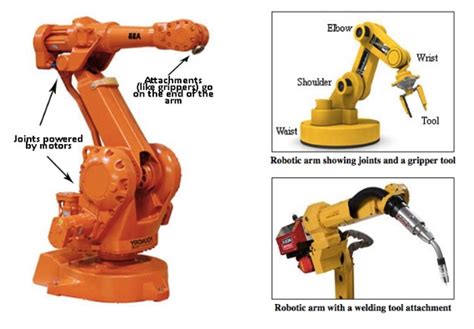Embracing the Precision and Power of Industrial Articulated Robots: A Comprehensive Guide
Introduction
Industrial articulated robots, with their unparalleled precision and versatility, are transforming manufacturing processes across diverse industries. These advanced machines empower businesses to achieve unparalleled levels of efficiency, accuracy, and productivity, paving the way for a new era of industrial automation.
Anatomy of an Industrial Articulated Robot
Industrial articulated robots typically consist of:
-
Base: Provides a stable foundation for the robot.
-
Arm: Consists of multiple segments connected by joints, allowing for a wide range of motion.
-
Wrist: Enables precise rotation and orientation of the end-effector.
-
End-Effector: The tool or fixture attached to the wrist, performing specific tasks such as welding, assembly, or packaging.
Top Applications of Industrial Articulated Robots
Industrial articulated robots are widely used in:

-
Automotive: Welding, assembly, painting, and material handling.
-
Electronics: Assembly, soldering, inspection, and testing.
-
Pharmaceuticals: Dispensing, packaging, and handling delicate materials.
-
Aerospace: Assembly, welding, machining, and inspection.
-
Food and Beverage: Packaging, sorting, and handling.
Key Benefits of Industrial Articulated Robots
-
Increased Production: 24/7 operation and reduced cycle times.
-
Enhanced Precision and Accuracy: Consistent quality and reduced defects.
-
Improved Safety: Eliminating hazardous tasks for human workers.
-
Reduced Labor Costs: Freeing up workers for more complex tasks.
-
Optimized Space Utilization: Compact design and flexible mounting options.
Advanced Features of Industrial Articulated Robots
-
Payload Capacity: Ranges from a few kilograms to over 1,000 kilograms.
-
Reach: Varies depending on the model and configuration.
-
Speed and Acceleration: High-speed models offer rapid cycle times.
-
Sensor Integration: Enables vision systems, force sensors, and other sensors for enhanced control.
-
Collaborative Operation: Robots designed to work safely alongside human operators.
Potential Drawbacks of Industrial Articulated Robots
-
High Initial Cost: Requires significant investment.
-
Complexity: Requires specialized programming and maintenance skills.
-
Limited Flexibility: May not be suitable for applications with frequent changes in production.
-
Safety Concerns: Proper installation and operation are essential to avoid accidents.
-
Maintenance Requirements: Regular maintenance is necessary to ensure optimal performance.
Tips and Tricks
-
Define Clear Objectives: Determine the specific tasks the robot will perform.
-
Research and Select the Right Robot: Consider payload, reach, speed, and other specifications.
-
Proper Installation and Maintenance: Follow manufacturer guidelines for safe operation and extended lifespan.
-
Employee Training: Train operators and maintenance personnel thoroughly.
-
Integrate with Other Systems: Explore options for seamless integration with existing systems.
Common Mistakes to Avoid
-
Underestimating Initial Costs: Include all expenses, including installation, programming, and maintenance.
-
Overestimating Capabilities: Realistically assess the robot's limitations.
-
Neglecting Safety Measures: Implement appropriate safety protocols.
-
Lack of Proper Training: Train all personnel involved in operation and maintenance.
-
Ignoring Maintenance Requirements: Regular maintenance is essential for optimal performance.
Why Industrial Articulated Robots Matter
In today's competitive manufacturing landscape, industrial articulated robots have become indispensable for businesses seeking to:

- Enhance productivity and efficiency.
- Improve product quality and consistency.
- Reduce operational costs and increase profitability.
- Address labor shortages and improve workplace safety.
Inspiring Success Stories
1. The Robot Barista
A café in Tokyo, Japan, employs an industrial articulated robot to prepare and serve coffee. The robot's precision movements and consistent brewing technique have made it a popular attraction, showcasing the versatility of industrial robots in unexpected applications.
2. The Robotic Artist

An artist in the United Kingdom uses an industrial articulated robot as a painting tool. The robot's controlled movements and ability to replicate complex patterns have opened up new artistic possibilities, demonstrating the robot's potential in creative fields.
3. The Autonomous Factory
A manufacturing facility in Germany has implemented a swarm of industrial articulated robots that work collaboratively to assemble products. The robots are programmed to adapt to changes in production schedules and handle a variety of tasks, highlighting the self-sufficiency and flexibility of advanced robotic systems.
Conclusion
Industrial articulated robots are the driving force behind the next industrial revolution. Their precision, power, and versatility make them essential tools for businesses seeking to enhance productivity, improve quality, reduce costs, and address critical challenges. By embracing these advanced machines, manufacturers can unlock a world of possibilities and secure their competitive advantage in the digital age.
Tables
| Payload Capacity |
Reach |
Speed |
Applications |
| 2 kg |
500 mm |
10 m/s |
Electronics assembly, small parts handling |
| 50 kg |
1,200 mm |
5 m/s |
Automotive welding, packaging |
| 500 kg |
2,000 mm |
2 m/s |
Heavy-duty welding, material handling |
| Feature |
Benefits |
Examples |
| Sensor Integration |
Enhanced accuracy, reduced cycle times |
Vision systems for object recognition, force sensors for assembly tasks |
| Collaborative Operation |
Improved safety, increased productivity |
Robots that work safely alongside human operators, reducing the risk of accidents |
| Remote Access & Monitoring |
Improved uptime, reduced downtime |
Remote diagnostics and troubleshooting, predictive maintenance |
| Pros |
Cons |
| High Precision |
High Initial Cost |
| Increased Productivity |
Complexity |
| Enhanced Safety |
Limited Flexibility |
| Reduced Labor Costs |
Safety Concerns |
| Optimized Space Utilization |
Maintenance Requirements |

